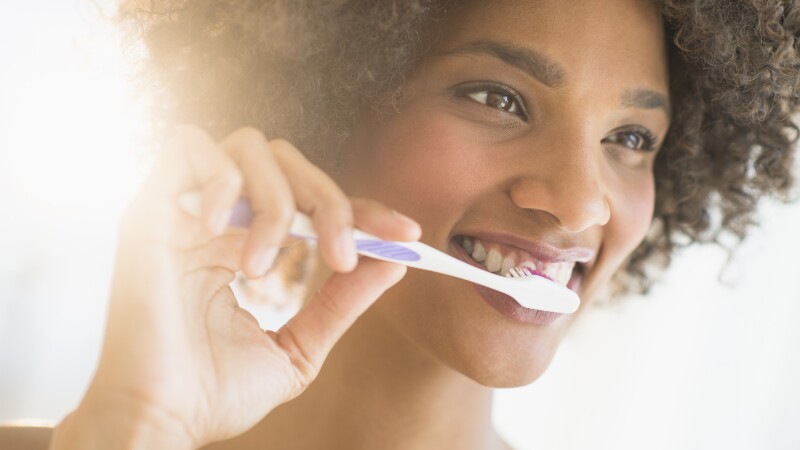Let’s be honest: Everyone has stinky breath at some point, whether it’s because you just devoured a plate of garlicky pasta or it’s been awhile since you last brushed.
“Bad breath, also known as halitosis, is a common complaint in one-third of the population,” says Wayne Aldredge, DMD, a periodontist based in Holmdel, New Jersey.
The primary cause: bacteria that live in your mouth and break down food, proteins and even skin cells, leading to the production and release of smelly volatile sulfur compounds (VSCs).
We asked experts to share the top causes of bad breath—and the best ways to eliminate bacteria and other halitosis culprits.
1.
Bacteria that take up residence on your tongue
The back of the tongue, especially, has many grooves and crevices, making it the perfect dwelling place for odor-producing bacteria to grow and emit VSCs.
What to do about it: While there’s no harm in using a tongue scraper to remove the gunk that accumulates on your tongue, the American Dental Association says there’s actually not that much proof that this gadget makes a substantial difference. “There’s probably a small effect, and it doesn’t last very long,” says Mary Lynn Bosma, DDS, Director of Oral Health, Johnson & Johnson.
Part of the issue is that most bad-breath bacteria accumulate all the way at the back of the tongue. A tongue scraper can’t reach that far without making you gag, and neither can your toothbrush, Dr. Aldredge points out. So a good way to effectively target this area is to use a safe-to-swallow substance that fights bad-breath bacteria and neutralizes VSCs.
One option: the new Listerine® Ready! Tabs™, which dissolve into a liquid upon chewing that is safe to swallow.
“They’re designed to stimulate saliva, reduce the activity of the bacteria that cause bad breath and neutralize—not just disguise—odor,” says Patricia Golas, Ph.D., Principal Scientist and R&D Lead, Oral Care Research, Johnson & Johnson.
2.
Plaque on your teeth
Plaque is a bacterial film that naturally forms on your teeth and gums and can lead to the production of lousy-smelling VSCs.
What to do about it: Seeing your dentist regularly is important, but a professional cleaning only keeps plaque at bay for a short time. “As soon as you eat and drink, the bacteria repopulate,” Dr. Bosma explains.
For this reason, a good at-home oral care routine is essential. “There are some components in toothpaste that may be antibacterial, but brushing is key because it physically removes bacteria,” she says.
After you brush, flossing can help remove particles in between your teeth. And using a mouth rinse like Listerine® Antiseptic further reduces bacteria on the teeth and tongue, and in between the teeth.
Brush and floss right away to get rid of any odiferous particles that might be stuck to your teeth. But don’t be surprised if your garlicky bad breath returns, since garlic can stay in your system for up to two days.
3.
Garlic and onions
Vegetables that are members of the Allium family—like garlic and onions—contain high concentrations of stinky sulfur compounds, explains Dr. Aldredge. When you crush them, you create allicin, a substance responsible for garlic’s strong aroma—and the smell you associate with it, he adds.
What to do about it: For starters, brush and floss right away to get rid of any odiferous particles that might be stuck to your teeth. But don’t be surprised if your garlicky bad breath returns, since garlic can stay in your system for up to two days.
“If you really like garlic and don’t want to give it up, then to a certain extent you have to suffer the consequences!” Dr. Bosma says.
4.
Dry mouth
Saliva is a natural deterrent to bad breath because it washes away bacteria. But many people suffer from dry mouth, which is exactly what it sounds like.
The main cause: prescription medications. There are many drugs that can cause your mouth to become parched, says Dr. Bosma. And if you take more than one of these meds, this side effect can get even worse.
What to do about it: Although some people find that special dry mouth lozenges help, sipping on water frequently can work just as well, suggests Dr. Bosma. Chewing sugar-free gum and sucking on sugar-free candy between meals may also make a difference. “When you chew something—anything—it stimulates your salivary glands,” she says.
5.
Certain medical conditions
Sometimes bad breath is a direct result of gum disease. But it can also be caused by allergies, lactose intolerance or diabetes. If you have diabetes, for example, and it’s not well-controlled, you can end up with ketones (a chemical byproduct of burning fat instead of glucose for energy), says Dr. Bosma—substances that can make your breath smell fruity or like nail polish.
What to do about it: If you have chronic bad breath that doesn’t seem to respond to any of the above remedies, it’s time to see your dentist and possibly your internist so you can identify the underlying health condition causing it, and get proper treatment.






